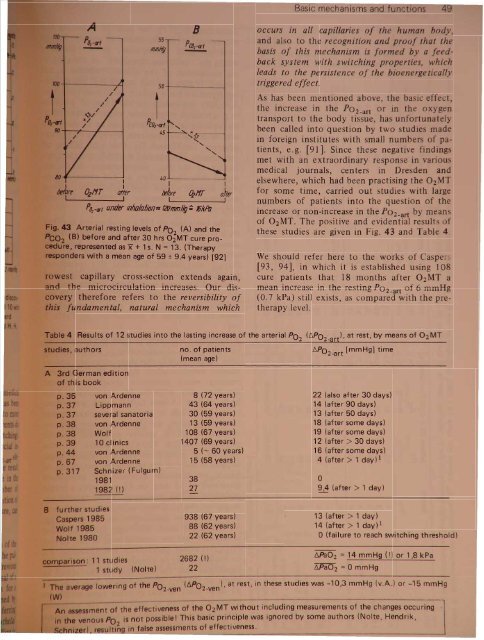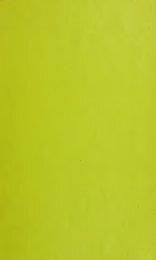hysiological foundations...fJJHT(JIll )' ,1002 3 ,5 6 7 I,r1""/rgIf L1..lD7 129 -- s,-,ZJt /tItJ,'. 117 7.45SJOr N-"- ~1!11l ",.l~~( N-1OP/Iz-.1 1-4 N-I,JTht i1crtfJsei11hr P/Iz-a1 IIJ8b lilt beller, the 11I0rt exactly Ihe 1Mpalienl R1IIDMS flit nstr"dion ofcomilllJinr doily t'Xef'&bt 1rtJining.'tJ A~tiliJn oIH1t' tIItropy is usually only 'SSOI"y ~1Itn astlll'rtstressful i1l!umae.g.'IIiJ, tpt'roliJn) ((JUst. flJt Po; tTl to,sinKIrJ6050l:N 10ortJUgN,y !Ittpre-hropy Itvtl.- 2 0 2 4 6 8 J) 12 14 16 18 20 22 24 26 28 30 32 .34 36 38 40 42 44 46 48 50 52 wrebt ..43Onlfdconlinutfus/y dro)pi/W.rofptl/;ens29complied wllh thertf/IIesi ltJra regtit1r hi/ow-upo 2 3 5 6t -15I10-7 8 9 10 11 12 I1KJflIIIsFig.41 Measurements showing the lasting, almost unchanged increase of the arterial P02 by means of the discoveredfunctional regeneration procedure for the lung-heart system on initially 53 subjects (groups of 43 and 10 witha mean age of 65.3 years and 62.6 years) without pronounced chronic unspecific lung diseases. Sx =standarddeviation; the 02-art increase is statistically significant at the 1% level; study made by H. G. Lippmann and H. H.Wiemuth in our Institute 1979/801.160;n ftlctors ~16 '23 ~.J) 1,,25POrirf10013mmIfJ'" e IrPa70 F-~=--+---t----t----i600 9 If 27 3617f ~ '7~~,gluessloIistf('(]l!y sgnliCllnl. rp-O,D5).'o,lJ,c,d,t: difftlMlZS !IIltIttn tk POrt!tFig. 42 Effect of the 02MT regeneration procedureon the arterial re ting P02 in 30 patients aged5 9 V a with roughlv normal blood pressur .i n from non pecialized cure institutions12"9This increase only gains considerable medicalsignificance with the fact, which now has beenstatistically proven, that it lasts for up to morethan a year, provided severe stressful events donot lead to a lasting reduction (switching).Figure 41 shows the results of a special investigationinto the duration of the P02_art elevationafter 3, 6, 9 and 12 months. The resultof a further study into the gradual rise in theP0 2 increase with an increasing number oftreatment hours, as well as into the duration ofthe effect after the end of the procedure anbe seen in Fig. 42.The regulating and wit hing m hani m f thmicrocirculation, th effe t of whi h in th pulnaryy tern i chara t tiz d in th pr . ufigure, i actually nothing but th r al fnatural pro e which ha b n kn n f rlong tim and ha be n larg I pI .n del ctron mi ro op [89 90]. r rrito th pr f th sw lling of th nd th l' Icells in O 2 deficiency. B u thi 1.
Basic mechanisms anunctions5511111;tfellz«4SB50+----_~I40~----......JI I IOzHT IIfItr ilion f£1ff ok--0oס1 ....1' , IP lIz « under inho/a/ion- 120mmHg ~8lrPaArterial resting levels of P02 (A) and the2 (B) before and after 30 hrs 02MT cure prore,represented as x + 1s. N = 13. (Therapynders with a mean age of 59 ± 9.4 years) [92]est capillary cross-section extends again,the microcirculation increases. Our diserytherefore refers to the reversibility offundamental, natural mechanism whichoccurs in all capillaries of the human body,and also to the recognition and proof that thebasis of this mechanism is formed by a feedbacksystem with switching properties, whichleads to the persistence of the bioenergeticallytriggered effect.As has been mentioned above, the ba ic effect,the increase in the P02-art or in the oxygentransport to the body tissue, has unfortunatelybeen called into question by two studie madein foreign institutes with small numbers of patients,e.g. [91]. Since these negative findingsmet with an extraordinary response in variousmedical journals, centers in Dresden andelsewhere, which had been practising the 02MTfor some time, carried out studies with largenumbers of patients into the question of theincrease or non-increase in the P0 2 _ artby meanof 02MT. The positive and evidential result ofthese studies are given in Fig. 43 and Table 4We should refer here to the works of Caspe.[93, 94], in which it is established using 108cure patients that 18 months after 02MT amean increase in the resting P02_art of 6 mmHg(0.7 kPa) still exists, as compared with the pretherapylevel.e 4Results of 12 studies into the lasting increase of the arterial P0 2(tP02-ar ), at rest, by means of 02MTdies, authors no. of patients toP02-art [mmHg] time(mean age)3rd German editionof this bookp.35.37p.37.38p.38p.39p.44p.67p.317f rther studiesCaspers 1985olf 1985olte 1980von ArdenneLippmannseveral sanatoriavon ArdenneWolf10 clinicsvon Ardennevon ArdenneSchnizer (Fulgum)19811982 (!)8 (72 years)43 (64 years)30 (59 years)13 (59 years)108 (67 years)1407 (69 years)5 (- 60 years)15 (58 years)3827938 (67 years)88 (62 years)22 (62 years)22 (also after 30 days)14 (after 90 days)13 (after 50 days)18 (after some days)19 (after some days)12 (after> 30 days)16 (after some days)4 (after> 1 day) 1o9,4 (after> 1 day)13 (after> 1 day)14 (after> 1 day) 1o (failure to reach switching threshold):ti:',.E!!E!r:!!i~on!!.:2682 (I) toPa02 = 14 mmHg (!) or 1,8 kPa11 studies1 study (Nolte) 22 ~ = 0 mmHgverage lowering of the P0 2- ven(flP02_ven), at rest, in these studies was -10,3 mmHg (v.A.) or -15 mmHgment of the effectiveness of the 02MT without including measurements of the changes occuringvenous Po is not possible I This basic principle was ignored by some authors (Nolte, Hendrik,in false assessments of effectiveness.ulti~
- Page 1 and 2: sand functl ni ove d cellular capil
- Page 3: 8 1. Physiological fou~dationsmmHga
- Page 6 and 7: Basic mechanisms and functions 11e
- Page 8 and 9: Basic mechanisms and functions 13pr
- Page 11 and 12: 500r-T_-+5__r-_-+1O__,....-_~15.1O-
- Page 13 and 14: ~IUI1!J ~atpWorMs---~~·tIIlDkeJ \I
- Page 15 and 16: y r na onabS,olu'te clla.ra~t ri ti
- Page 17 and 18: 100907065"I 4y iological foundation
- Page 19 and 20: 1. hy lologlcal foundations70"''''J
- Page 21 and 22: CII'Cli8LC outl)ut VAr;lllil i e re
- Page 23 and 24: -'0 y 101091cai oundatlons80%6050l~
- Page 25 and 26: ,..._........,.--~"'!""!!'!~~----_.
- Page 27 and 28: hi v d in h arrangement shown above
- Page 29 and 30: 34 1. Physiological foundations70%6
- Page 31 and 32: logical foundationsu .on in the opt
- Page 33 and 34: 1. Physiological foundations. ~ la~
- Page 35 and 36: II foundationsI tem IBPtrsons with
- Page 37: 1. Physiological foundationsAirdosi
- Page 40 and 41: 110N.ttJJOt~1. Physiological founda
- Page 42 and 43: 1. Phy iological foundationsAnoO;HT
- Page 46 and 47: 1. Physiological foundationsCOCOM I
- Page 48 and 49: g r d, whi h con iderably contribut
- Page 50 and 51: logical foundations13IrPtz12.......
- Page 52 and 53: ,. Physiological foundationsIf-RoN
- Page 54 and 55: 1. Physiological foundationsAll"i1t
- Page 56 and 57: ~~itItINitIIJq/s N 31 54 52~IBIP~-.
- Page 58 and 59: BDuring OzMTprocedurecAfter OzMTpro
- Page 60 and 61: A Bi3lrfss 1'1oafofmovement 8 0pl'r
- Page 62 and 63: Table 6 PO b measurements of unsele
- Page 64 and 65: serert~ hyperoxia pure 0 } .distres
- Page 66 and 67: IIstress qirI/iII mn wryhJI1IJSISLo
- Page 68 and 69: A/JtfJtnk«P~1Mtrr'ttriIWIItJfIS~.~
- Page 70 and 71: Table 7 The change in the architect
- Page 72 and 73: nsMslor rotd'1uI.-Jl!Jg1"/11(J(Jrfr
- Page 74 and 75: IonsFig. 74 Histological pictures s
- Page 76 and 77: IonseM' Selecfofherm equipment-_s1S
- Page 78 and 79: .....-------................',..,-n
- Page 80 and 81: eM/rot gro"/!.Histologicallyconfirm
- Page 82 and 83: A1er tnit,almonipulotionsand III«l
- Page 84 and 85: Q'CSlNltftning1A. QfQ/-fJlf1inguQ
- Page 86 and 87: otllm'lv.2 h th ju tifi d pro p ct
- Page 88 and 89: t48xlD J WsEhmmahooofMe ~crdieal, c
- Page 90 and 91: old°z-/ImitMW mode of calcu/aflonC
- Page 92 and 93: he cylindr'cal area upplied by the'
- Page 94 and 95:
Tn-T-~-----1~--~--~JaluralttJtranSi
- Page 96 and 97:
aPI)Ii:lcati?n with a patially very
- Page 98 and 99:
are triggered. At the same site, ho
- Page 100 and 101:
n respired again, the drop in respi
- Page 102 and 103:
Exholationtubeloop aroundcmebroncll
- Page 104 and 105:
[Xeftt of,t"". Respiratorv... stand
- Page 106 and 107:
ventieFig. 112 pH decrease between
- Page 108 and 109:
BIncorporation ofJ5s-slI"ate intofh
- Page 110 and 111:
~LFig. 115 Electron micrograph of h
- Page 112 and 113:
12111098V ~ .-"~"' .....b""", ".1Tt
- Page 114 and 115:
,,,;tt cola;, ofH1e 88JIJitKIJIIl "
- Page 116 and 117:
"-1r-180 I'\112007(J)Jr' '- jwry¥I













